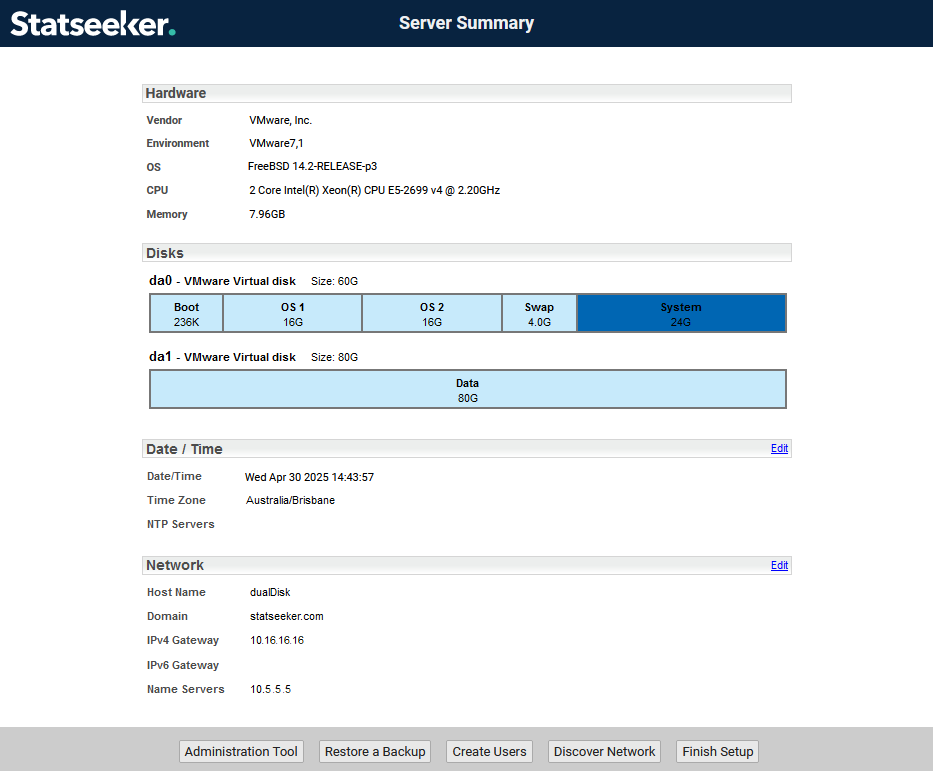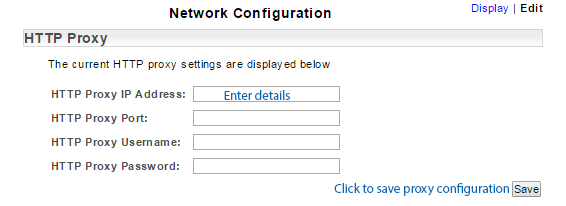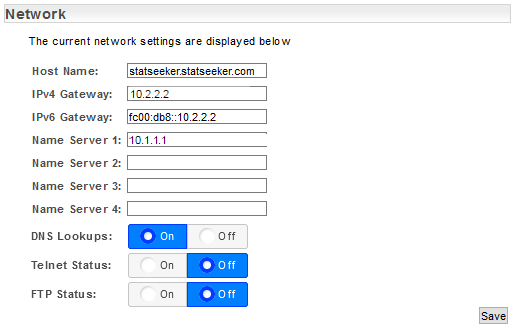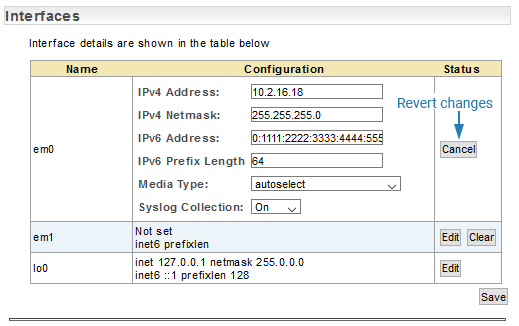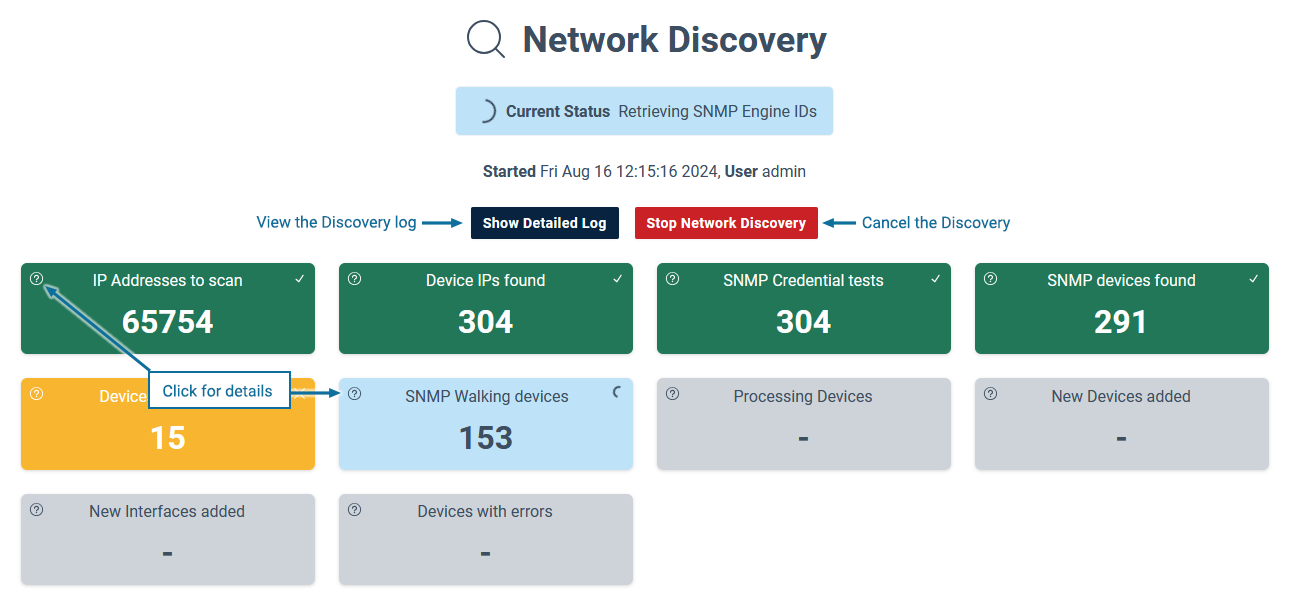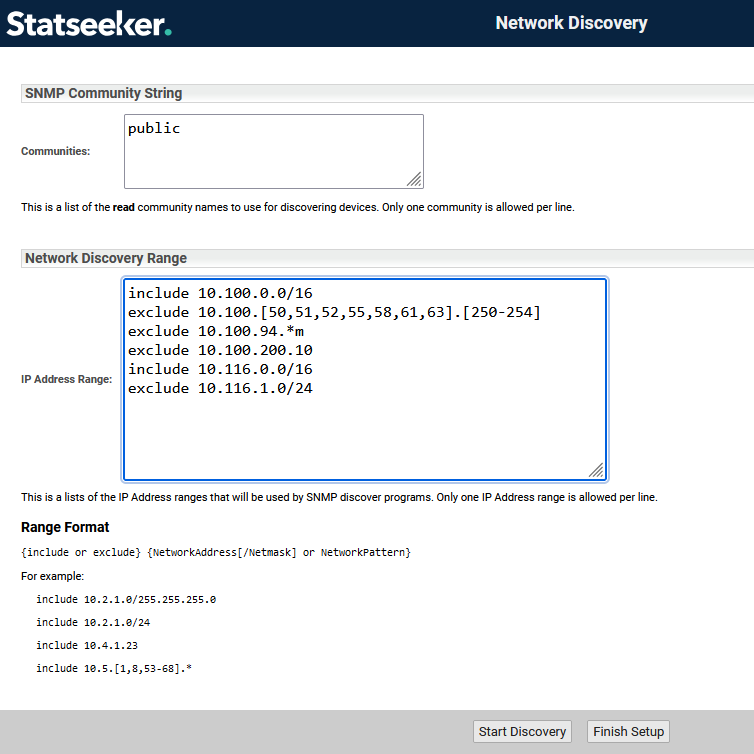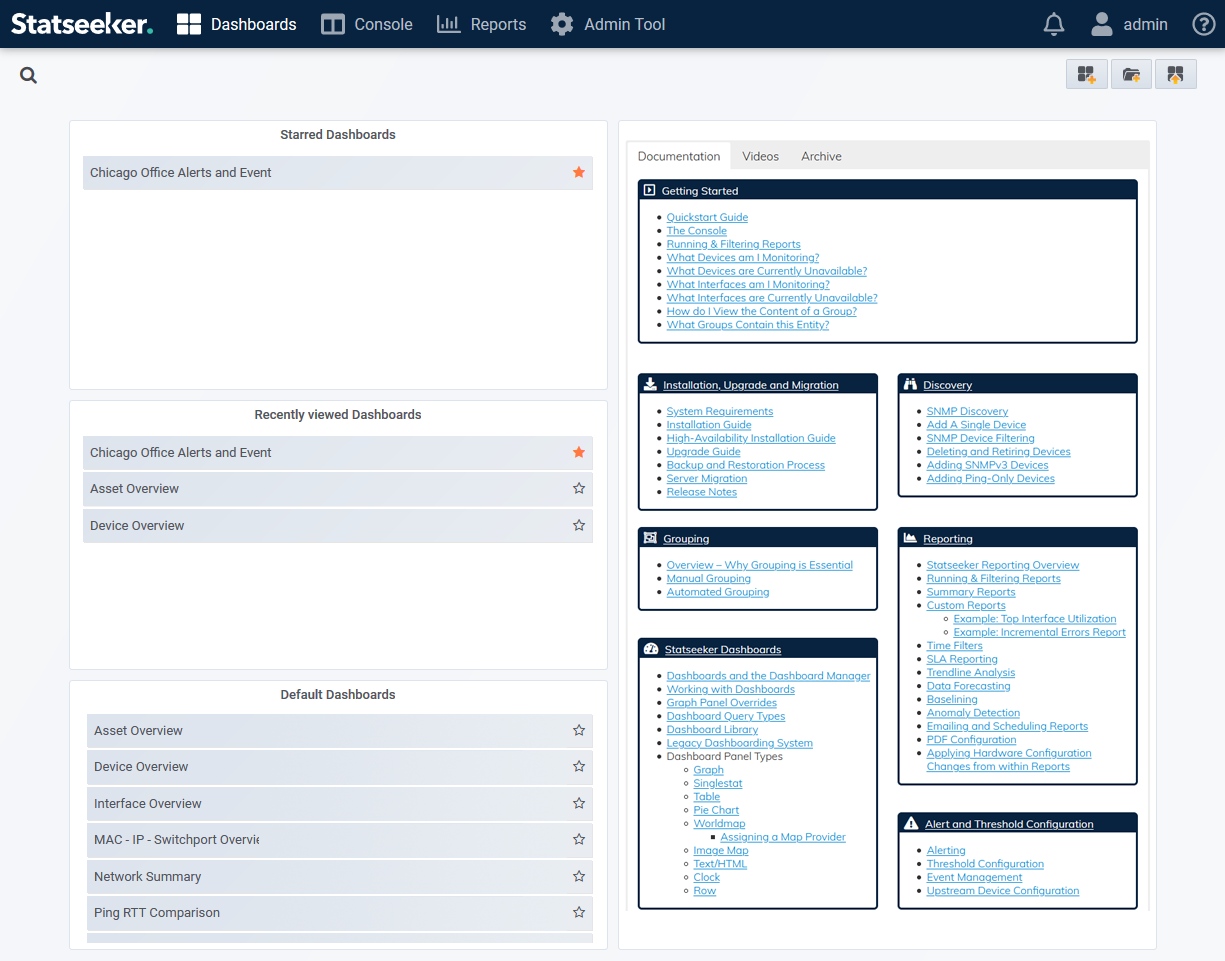Index
- Overview
- Requirements
- Format Installation File
- Authenticate and Set Project
- Upload Statseeker Installation File
- Create Image
- Create Statseeker Virtual Machine
- Server Licensing
- Server Summary and Final Steps
- Apply Service Packs
- Update Default Passwords
Overview
Statseeker can be deployed to Google's Cloud platform. This document outlines the process of creating a Google Cloud Statseeker deployment via the Google Cloud Console (GUI) and the Google Cloud SDK Shell (CLI).
- Any screenshots presented, and processes described were accurate at the time of writing this document, but may become out-of-date due to changes made to the Google Cloud platform
Requirements
This process assumes that you have a working knowledge of the Google Cloud platform and portal, and requires that you have:
- A valid Google Cloud subscription with access to Google Compute Engine services
- Access to a pre-configured Project, or permission to create a Project
- Access to a pre-configured Storage Bucket, or permission to create a Storage Bucket
- The Google Cloud SDK Shell installed on the local machine (required for Statseeker v5.6.2 and v25.2 only)
- A Statseeker v5.6.1, v5.6.2, or v25.2 installation image
- Depending on the format of the image, you may need access to a Linux system to re-format the image prior to use on the Google Cloud platform, see Format Installation Image for details
- A valid Statseeker license
For access to Statseeker files/licenses suitable for your needs, please contact:
- New accounts: your Regional Sales Manager
- Existing Statseeker Accounts: Statseeker Technical Support
Format Installation File
The Google Cloud platform expects the installation image used when configuring Compute Engine Services to be provided in a specific format. Depending on the Statseeker version you are intending to use, the installation image format provided by Statseeker will be either:
- A ready-to-use compressed TAR archive (*.tar.gz) - proceed to Upload Statseeker Installation Media
- A Statseeker VHD image (*.vhd) - see below
If you have a Statseeker VHD, you will need to format this image prior to uploading to Google Cloud.
- Rename the VHD to disk.raw - Google Cloud explicitly looks for this file
- Tar and compress this image using a specific operation switch (requires access to a Linux system)
Use the following commands on a Linux CLI to rename and process the installation image:
# cp <your_statseeker_vhd_filename>.vhd disk.raw # tar --format=oldgnu -Szcf <output_filename>.tar.gz disk.raw
Example:
# cp statseeker.vhd disk.raw # tar --format=oldgnu -Szcf statseeker-25.2.tar.gz disk.raw
Authenticate and Set Project
If you are either creating a Statseeker v5.6.2+ VM (via the GUI or CLI), or creating a v5.6.1 via the CLI, then you will need to authenticate with the Google Cloud SDK Shell and set the default project.
- Open the previously installed Google Cloud SDK Shell console and run the following commands
gcloud auth login gcloud projects create <PROJECT_ID> # omit this step if you have a suitable project gcloud config set project <PROJECT_ID>
Example:
gcloud auth login gcloud projects create my-statseeker-project gcloud config set project my-statseeker-project
Upload Statseeker Installation Media
The Statseeker TAR file created in the previous step needs to be uploaded to a Google Cloud Storage Bucket before it can be used to Statseeker server instances.
- If you have a suitable storage bucket, then proceed to Uploading Installation Media
- If you need to create a storage bucket, proceed to Create Storage Bucket
Create Storage Bucket
- Log in to your Google Cloud Account
- From the main menu, select Cloud Storage and select your chosen Project
- Click Create Bucket and Name your bucket
- Set Location, Storage Class, and Access Control to suit your requirements
- Click Create
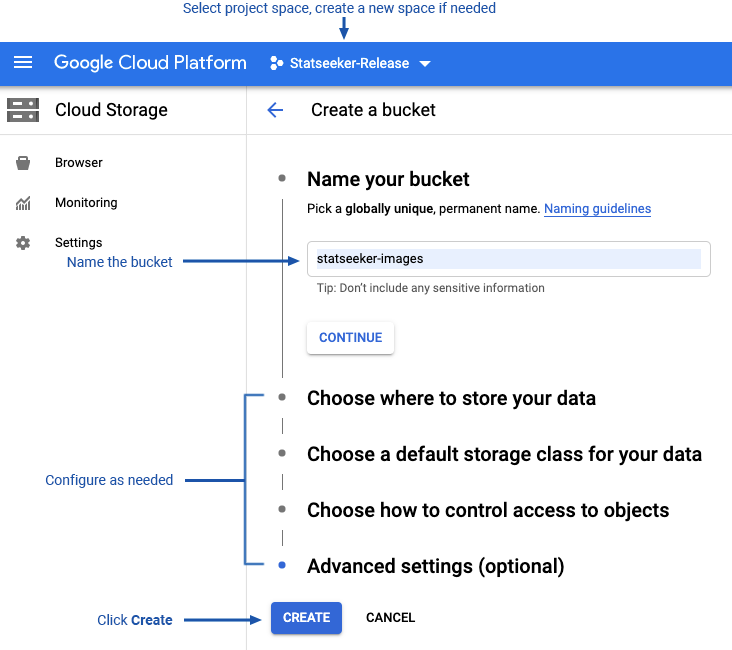
Via the CLI
gsutil mb -p <PROJECT_ID> gs://<BUCKET_NAME>
Example:
gsutil mb -p my-statseeker-project gs://my-statseeker_bucket
Uploading Installation File
- Log in to your Google Cloud Account
- From the dashboard, select Cloud Storage and select your chosen Project
- Select the bucket that will contain the Statseeker installation file and click Upload Files
- Locate and select the Statseeker TAR
Once uploaded, the Statseeker image will be displayed in the bucket.
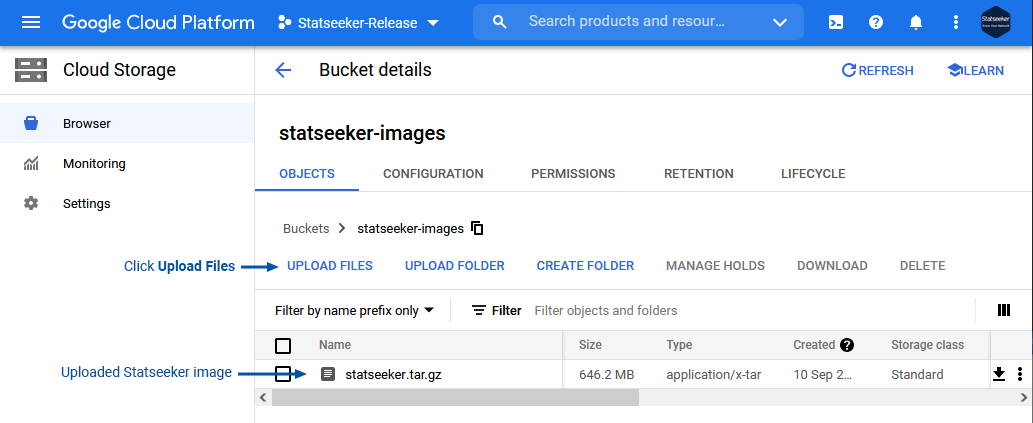
Via the CLI
gsutil cp <IMAGE_ARCHIVE> <CLOUD_STORAGE_BUCKET>
Example:
gsutil mb -p statseeker-25.2.tar.gz gs://my-statseeker_bucket
Create Image
We need to create a Google disk image from the uploaded installation file.
- Log in to your Google Cloud Account and select your chosen Project
- From the main menu, select Compute Engine > Images
- Click Create Image
- Name the image
- Set Source = Cloud Storage file and select the Statseeker installation file that was previously added to your storage bucket
- Set Location, Family, Description, Tags, and Encryption as needed for your organization
- Click Create
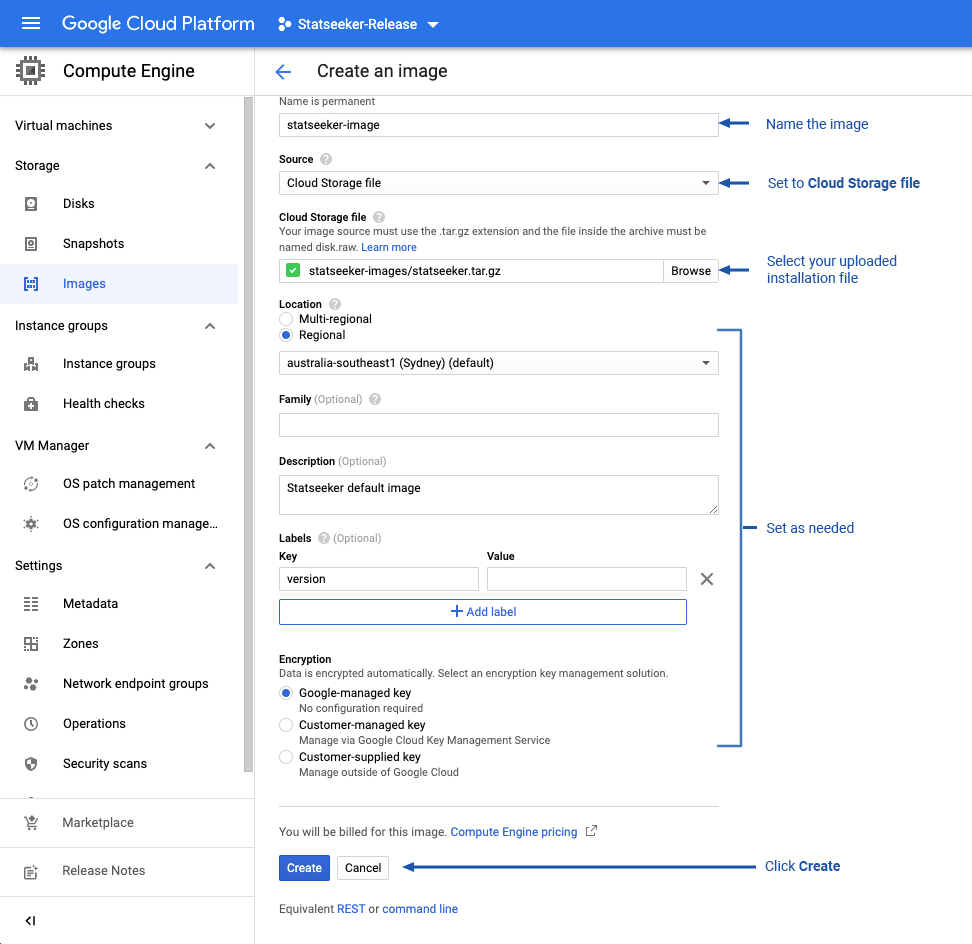
The image creation process may take a few minutes to complete your image listing will update with the new image once complete.

Via the CLI
You may need to remove the trailing back-slash (\) and line-breaks, as we have done for the examples which are all presented as single-line content.
gcloud compute images create <IMAGE_NAME> \ --project=<PROJECT_ID> \ --description="<IMAGE_DESCRIPTION>" \ --source-uri=<IMAGE_URI> \ --labels=version=<IMAGE_VERSION> \ --storage-location=<REGION> \ --guest-os-features="UEFI_COMPATIBLE" # this line is only required for Statseeker v5.6.2+, omit for earlier versions
Example:
gcloud compute images create statseeker-2520-image --project=my-statseeker-project --description="statseeker2520" --source-uri=gs://my-statseeker_bucket/statseeker-25.2.tar.gz --labels=version=2520 --storage-location=australia-southeast1 --guest-os-features="UEFI_COMPATIBLE"
Create Statseeker Virtual Machine
- Log in to your Google Cloud Account and select your chosen Project
- From the main menu, select Compute Engine > Images
- Locate your Statseeker image and select Actions > Create Instance
- Set the VM Name, hostname (see below), and Region\Zone - these items cannot be altered after the VM is created
- Select Advanced options > Networking
- Specify the custom Hostname
The hostname can be verified after VM creation by:
- Going to VM Instances and selecting your Statseeker instance to open Instance Details
- Review the Hostname section (this section is only visible if a custom hostname has been applied).
- Specify the Machine Configuration and Boot Disk to suit your needs according to the Statseeker System Requirements
- Set Firewall = Allow HTTPS traffic
- Click Create
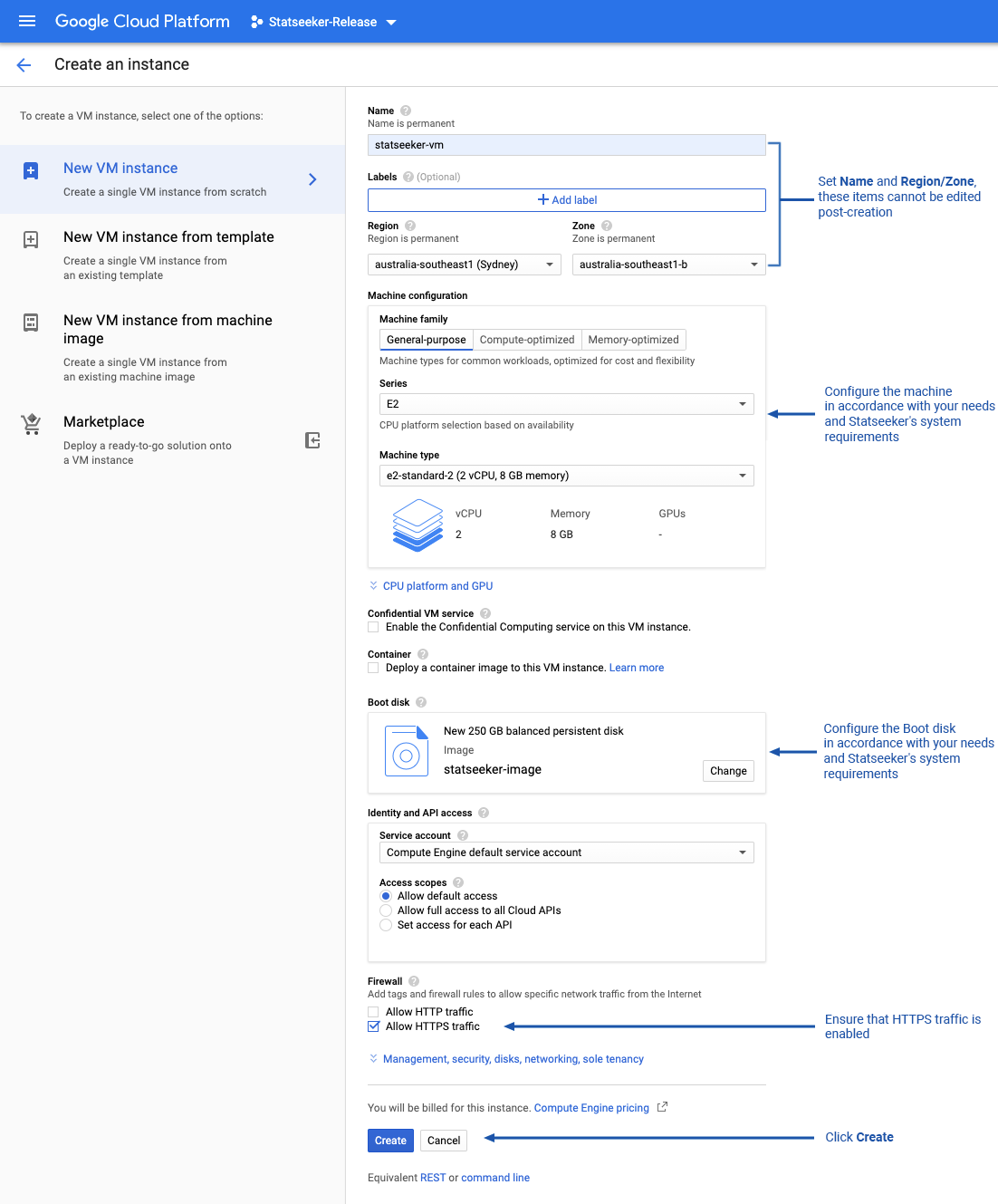
Via the CLI
gcloud compute instances create <INSTANCE_NAME> \ --hostname=<HOSTNAME> \ --project=<PROJECT_ID> \ --zone=<ZONE> \ --machine-type=<MACHINE_TYPE> \ --subnet=<SUBNET> \ --network-tier=<NETWORK_TIER> \ --maintenance-policy=<MAINTENANCE_POLICY> \ --scopes=<SCOPES> \ --tags=<TAGS> \ --image-project=<PROJECT_ID> \ --boot-disk-size=<DISK_SIZE> \ --boot-disk-type=<DISK_TYPE> \ --boot-disk-device-name=<DEVICE_NAME>
Example:
gcloud compute instances create my-statseeker-server --hostname=my-hostname.example.com --project=my-statseeker-project --zone=australia-southeast1-b --machine-type=e2-standard-2 --subnet=default --network-tier=PREMIUM --maintenance-policy=MIGRATE --scopes=https://www.googleapis.com/auth/devstorage.read_only,https://www.googleapis.com/auth/logging.write,https://www.googleapis.com/auth/monitoring.write,https://www.googleapis.com/auth/servicecontrol,https://www.googleapis.com/auth/service.management.readonly,https://www.googleapis.com/auth/trace.append --tags=https-server --image=statseeker-2520-image --boot-disk-size=250GB --boot-disk-type=pd-balanced
The VM will be created, the list of VM instances will be updated with your new Statseeker VM, and the Statseeker installation process will begin.
- Select the new Statseeker VM instance to view the VM's details
- Select Logs > Serial port 1 (console) to view the current state of the Statseeker installation process
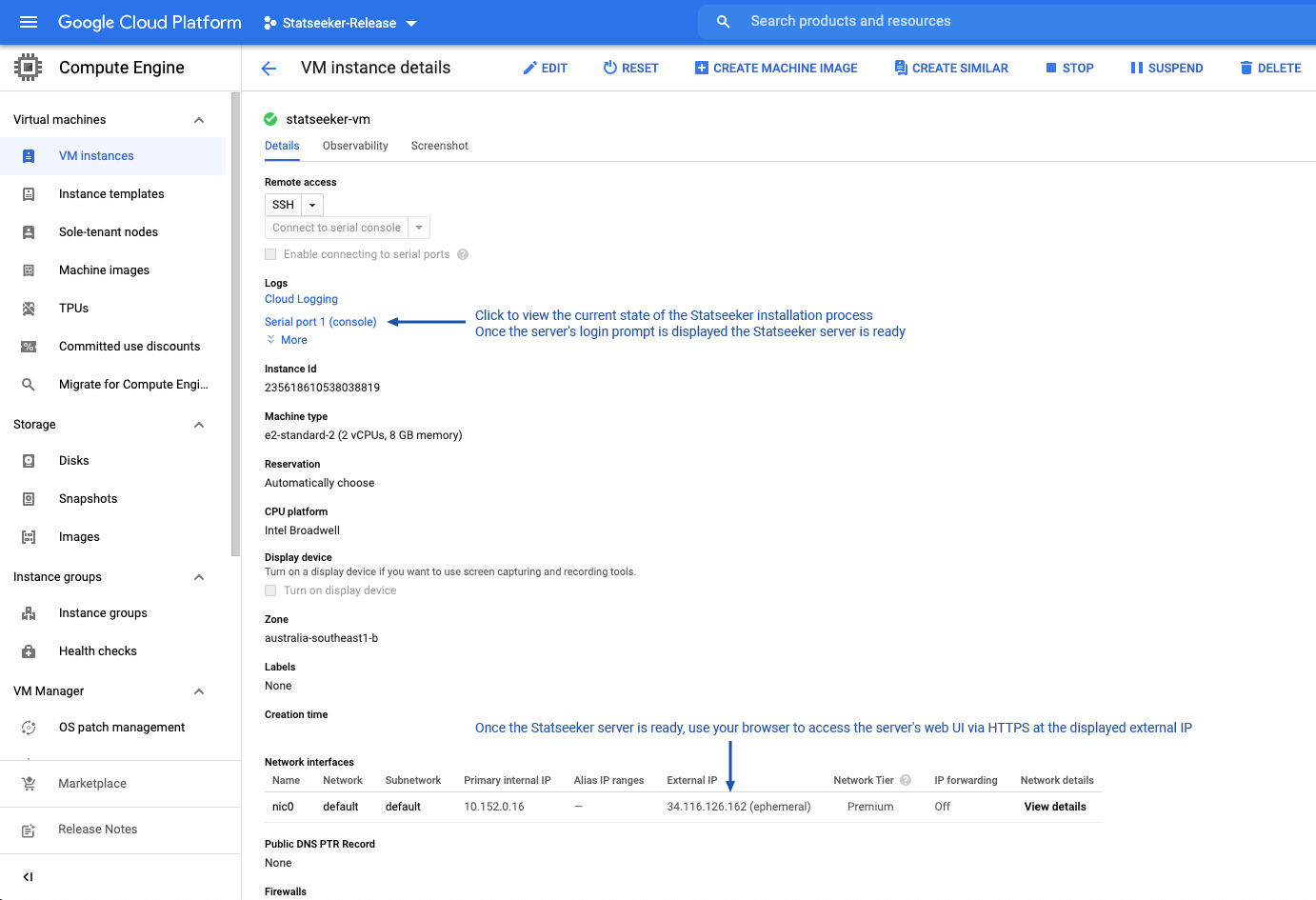
- Refresh the log output until the login prompt is displayed
- Access the Statseeker server's web UI in your local browser via HTTPS at the VM's external IP address
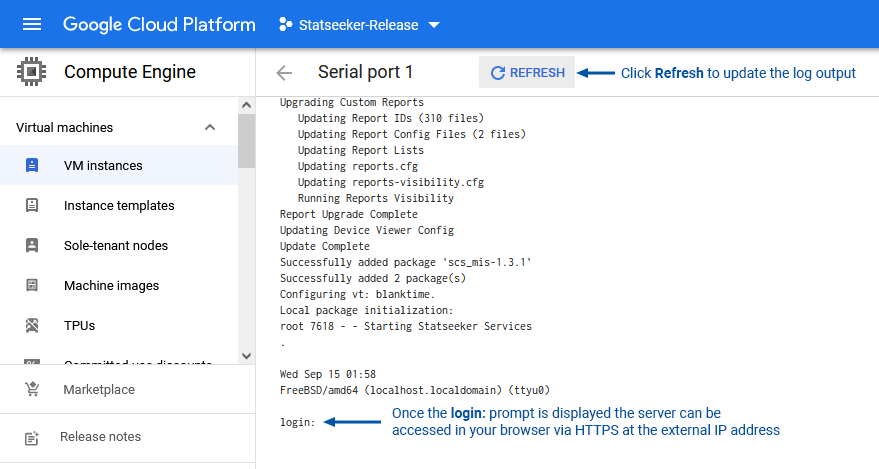
Via the CLI
gcloud compute \ --project=<PROJECT_ID> instances get-serial-port-output <INSTANCE_NAME> \ --zone=<ZONE> \ --port=1 # Returns the console output
Example:
gcloud compute --project=my-statseeker-project instances get-serial-port-output my-statseeker-server --zone=australia-southeast1-b --port=1
Server Licensing
By default, the Statseeker web server will use HTTPS in conjunction with a self-signed certificate. Modern browsers will view self-signed certificates as potentially suspect and post an alert prior to loading the Statseeker interface for the first time. To suppress any future alerts for that specific certificate:browser combination:
- Follow the browser prompts to acknowledge the risk and add an exception for the certificate
For details on how to upload and use alternative SSL certificates or configure the server to use HTTP instead, see Web Server Configuration.
You will then be prompted with a login screen.

- User Name - admin
- Password - statseeker
Once logged in to the web interface, you will be prompted with the Statseeker License configuration screen.
- Enter your Server ID and select Download a new Key
It may take a minute or two to obtain your license key.
- Select the checkbox to accept the Statseeker license
- Select Save to activate the license key

The screen will update to display the license details.

- Click Next
Multi-Disk Servers
If your Statseeker server has multiple disks, you will be given the option to assign another disk as the repository for Statseeker data. This screen will only be displayed if Statseeker detects more than one disk.
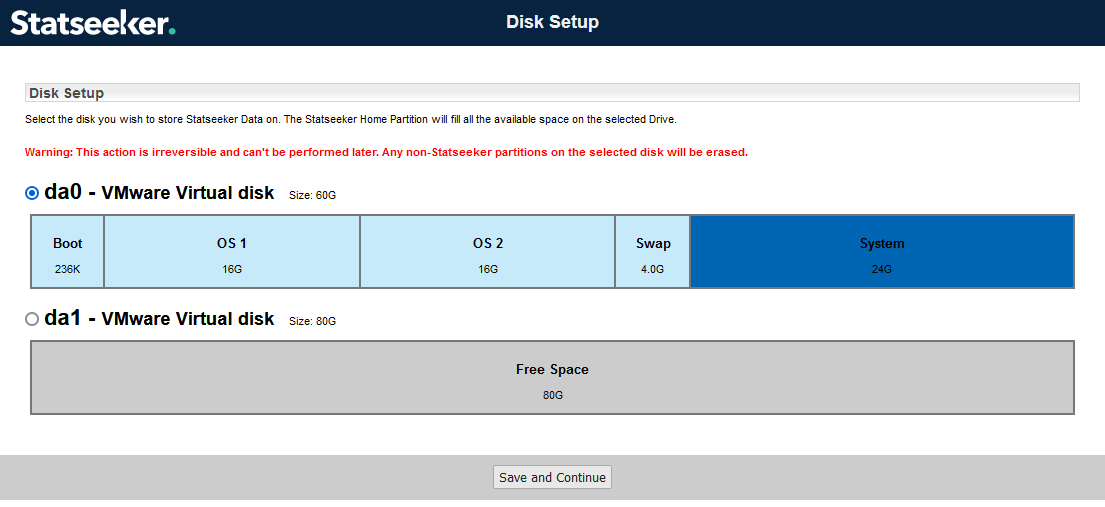
Prepare Secondary Disk for Statseeker Data
Optionally, you can store all Statseeker data on another disk on the server. Assigning a disk as the repository for Statseeker data will delete all current content on the disk.
To store Statseeker data on a second disk:
- Select the disk that will act as the Statseeker data repository - all existing data on this drive will be erased
- Click Save and Continue, then confirm the decision when prompted
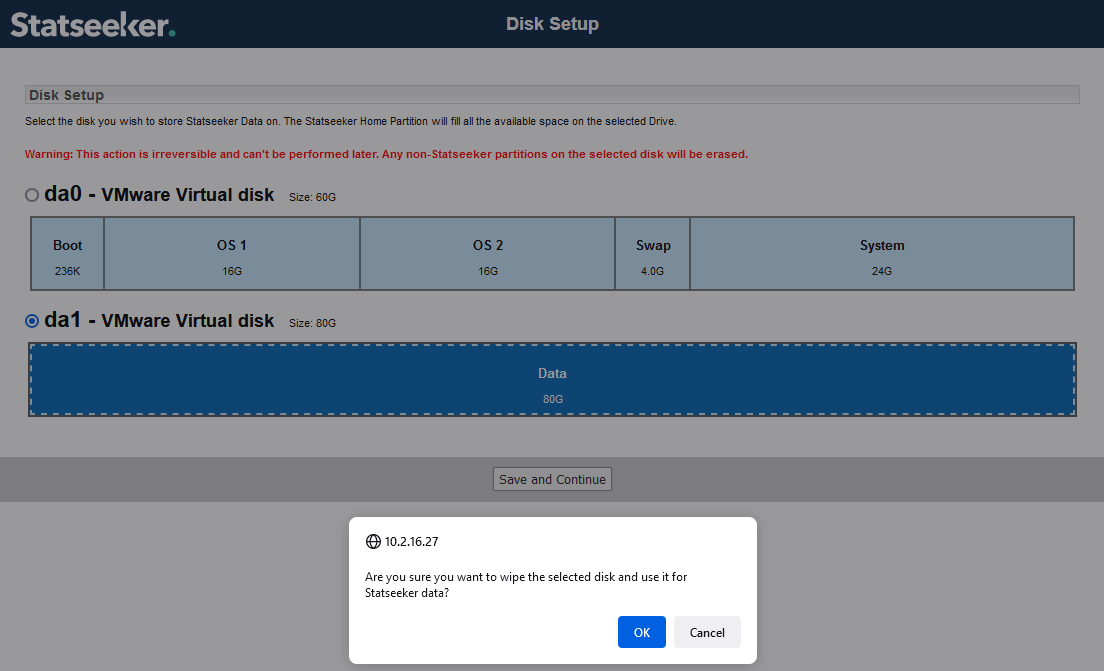
You may need to re-authenticate with the server once this process has been completed.
You will now be presented with the Server Summary screen, containing a range of details pertinent to your Statseeker installation.
Server Summary and Final Steps
The Server Summary details the configuration of your Statseeker server with options to update this configuration and initiate basic server administration tasks.
- Edit Server Date/Time - edit the server date/time/timezone, this action will reboot the server
- Edit NTP Configuration - edit and test the NTP server configuration
- Server Proxy Settings - configure an HTTP proxy connection for the Statseeker server
- Edit the Network Configuration - edit hostname, IP (primary interface), DNS settings, and enable telnet/ftp communications to the server
- Edit Interface Configuration
- Admin Tool - access all Statseeker configuration and administration options
- Restore from Backup - restore a Statseeker server backup onto the server
- Create Users - create additional Statseeker server user accounts
- Run Network Discovery - direct Statseeker to begin monitoring your network
- Finish Setup - take no further action (all options are available from within the Admin Tool) and exit the setup process
Edit Server Date/Time
This is an optional step, adjust the settings if required.
- Click the associated Edit link on the Server Summary page
- Use the calendar control to edit the date and/or time
- Use the drop-down to modify the timezone for the server
- Click Save when done
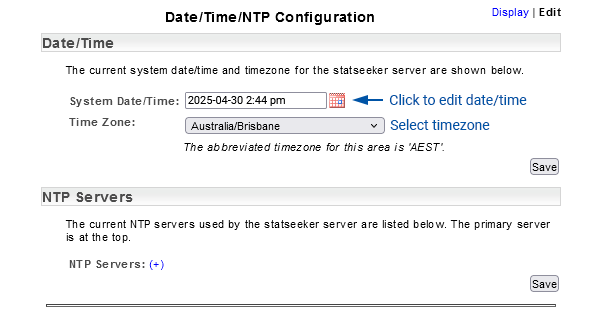
The configuration changes will be saved, and the server will be restarted to apply those changes.

Once the changes have been applied, you will be returned to the Date/Time/NTP Configuration screen (in Display mode) to confirm that the changes have been applied correctly.
Edit NTP Configuration
To edit the NTP server settings:
- Click the associated Edit link on the Server Summary page
- Enter the address of the NTP server to use
- Click the associated Delete button to remove unwanted NTP server entries
- Click Save when done
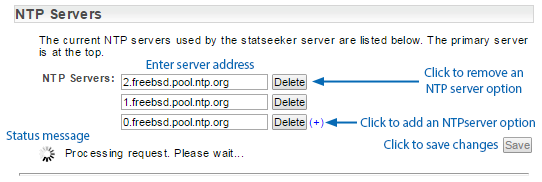
When you click Save, Statseeker will attempt to contact the specified NTP servers and:
- Inform you if it is unable to receive a response from the NTP server, no changes have been applied at this point
- If it receives a valid response from the NTP server, apply the changes and return the Date/Time/NTP Configuration screen (in Display mode), enabling a Test button that can be used to confirm the validity of the current configuration.
Configure an HTTP Proxy Connection
To add or edit the HTTP proxy configuration:
- Click the Network > Edit link on the Server Summary page
- Enter the required proxy server details
- Click Save to apply the configuration
Edit the Network Configuration
To edit the existing network configuration:
- Click the Network > Edit link on the Server Summary page
- Enter the required details
- Click Save to apply the configuration
Edit Interface Configuration
To edit the existing network configuration:
- Click the associated Edit link on the Server Summary page
- Click Edit to reconfigure the interface, optionally click Clear to remove the current configuration before editing

- Enter the required details
- Click Save to apply the configuration
- Click Close to return to the Server Summary
Admin Tool
The Admin Tool is used to manage your Statseeker server and houses a large amount of functionality, including:
- Statseeker server licensing and configuration (operating system, web server, SSL certificates, authentication options, backups, custom packages, etc.)
- Network discovery and device management
- User accounts
- Group management
- Alerting and event management
- Server Maintenance and Troubleshooting
See Server Administration for additional information.
Restore from Backup
This option allows you to restore a previous Statseeker server backup onto the newly created server. The backup will restore both the Statseeker server configuration (optionally including SSL certificates) and network data (as recorded up until the backup was created)
For more information, see Backup and Restoration Processes.
Create Users (optional)
This option allows you to configure additional Statseeker user accounts, see User Accounts for details on account creation. This step can be skipped as user account creation is available from within the Admin Tool after installation is complete.
There are some limitations to creating user accounts at this time:
- User Authentication - only File authentication is available at this time. Other authentication methods (LDAP, RADIUS, SAML) can be configured post-installation, see User Authentication for details
- Group Selection - as no groups have been created\populated at this time, only the All Groups super-group is available, see Grouping Overview for details
The additional actions offered are:
- Back - return to the installation Server Summary
- Log Out - complete the installation process and log out of the Statseeker server
- Finish Setup - complete the installation process, you will be sent to Dashboards (the default Statseeker landing page, see Console Options for updating this default)
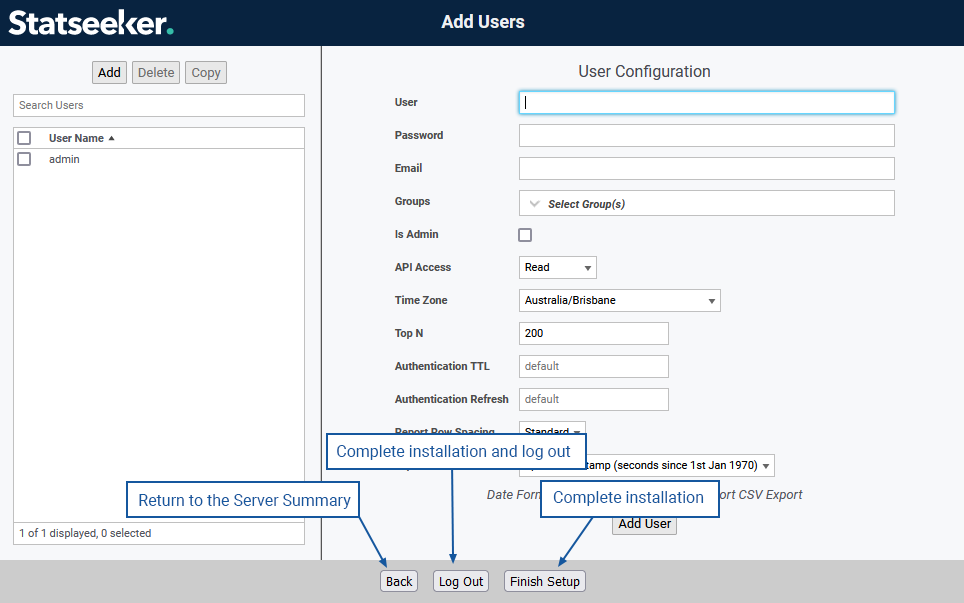
Run Network Discovery
Statseeker's network discovery process is used to add networked devices, interfaces, and other SNMP-enabled components on your network to Statseeker. Statseeker can then collect configuration information and timeseries data from those devices to be used for polling, reporting, and alerting purposes.
Finish Setup
The Statseeker Dashboard Homepage will be displayed, providing access to the default dashboards as well as a news panel detailing recent updates with links to associated documentation and videos. The main Statseeker Console and reporting panels are available from the main navigator.
Apply Service Packs
Check for and apply any Service Packs applicable to your version of Statseeker. Contact Customer Support if you require any assistance.
Update Default Passwords
The installation process creates the following administrative system accounts:
- admin – the web user administrator account
- statseeker – the system user account used by the Statseeker application
- root – the superuser account in the backend operating system
You will need to update the passwords assigned to these accounts. To do this:
- Select Admin Tool > Statseeker Administration > OS Configuration
- Click Edit (top-right)
- Update the passwords for the root, statseeker, and admin accounts

